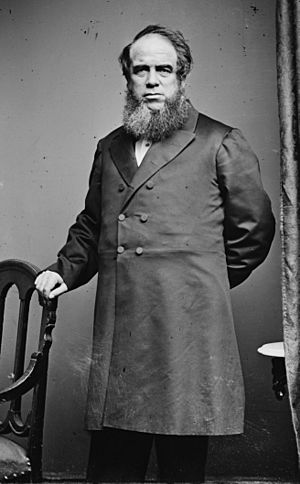Francis William Kellogg facts for kids
Quick facts for kids
Francis William Kellogg
|
|
|---|---|
 |
|
| Member of the U.S. House of Representatives from Alabama's 1st congressional district | |
| In office July 22, 1868 – March 3, 1869 |
|
| Preceded by | James Adams Stallworth |
| Succeeded by | Alfred Buck |
| Member of the U.S. House of Representatives from Michigan's 4th congressional district | |
| In office March 4, 1863 – March 3, 1865 |
|
| Preceded by | Rowland E. Trowbridge |
| Succeeded by | Thomas W. Ferry |
| Member of the U.S. House of Representatives from Michigan's 3rd congressional district | |
| In office March 4, 1859 – March 3, 1863 |
|
| Preceded by | David S. Walbridge |
| Succeeded by | John W. Longyear |
| Member of the Michigan State House of Representatives | |
| In office 1857–1858 |
|
| Personal details | |
| Born | May 30, 1810 Worthington, Massachusetts |
| Died | January 13, 1879 (aged 68) Alliance, Ohio |
| Nationality | American |
| Political party | Republican |
| Military service | |
| Branch/service | Union Army |
| Rank | Colonel |
| Battles/wars | American Civil War |
Francis William Kellogg (born May 30, 1810 – died January 13, 1879) was an important American politician. He served as a U.S. Representative for two different states. He represented Michigan during the Civil War. Later, he represented Alabama during the time known as Reconstruction.
Contents
Early Life and Moving West
Francis William Kellogg was born in Worthington, Massachusetts. He went to local schools there. In 1833, he moved to Columbus, Ohio. Later, in 1855, he moved to Grand Rapids, Michigan.
In Michigan, he started a successful lumber business. His company was called Kellogg, White & Co. A town called Kelloggville in Kent County, Michigan, was even named after him! Before joining the national government, he served in the Michigan State House of Representatives. He was a member of this state government from 1857 to 1858.
Serving Michigan in Congress
Kellogg was a member of the Republican Party. He was elected to the United States House of Representatives from Michigan. He served three terms in Congress. These terms were from March 4, 1859, to March 3, 1865.
He first represented Michigan's 3rd congressional district. After some changes to the districts, he then represented the 4th district. In all his elections, he won against Thomas B. Church. Church was a former mayor of Grand Rapids.
Helping During the Civil War
During the American Civil War, Francis Kellogg played a big role. He helped create several army groups. These were the Second, Third, and Sixth Regiments. He did this with permission from the United States Department of War. He was also given the rank of colonel for the Third Michigan regiment.
A New Role in Alabama
After the Civil War, during the Reconstruction period, Kellogg took on a new job. U.S. President Andrew Johnson appointed him to a position in Alabama. He became the collector of internal revenue for the southern part of Alabama. This meant he was in charge of collecting taxes. He served in this role from April 30, 1866, until July 1868. During this time, he lived in Mobile, Alabama.
When Alabama was allowed to rejoin the United States, Kellogg was elected to Congress again. He served a short term for Alabama's 1st congressional district. This was from July 22, 1868, to March 3, 1869. After his term, another Republican, Alfred Buck, took his place.
Later Life
After his time in Congress, Francis Kellogg moved to New York City. Later, he moved to Alliance, Ohio, where he passed away. He is buried in the Fulton Street Cemetery in Grand Rapids, Michigan.

